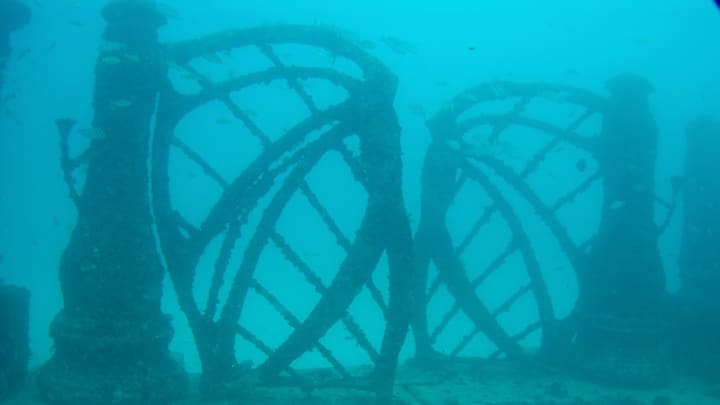The U.S. is filled with stunning cemeteries, but a location for remains in Florida has a feature that sets it apart: It's located underwater. You can take a virtual dive through the Neptune Memorial Reef via the video below.
The Neptune Cremation Society first established the site about 3.25 miles off Miami Beach in 2007. Expanding the artificial reef has been an ongoing process, and once construction is complete, it will be large enough to hold the remains of 250,000 people across 16 acres.
The cremains of 1000 individuals have already been put to rest 40 feet below the surface of Biscayne Bay. In place of graves, the reef is filled with sculptures of sea creatures such as octopuses and sea turtles. The ashes of the deceased are mixed with the concrete before its molded into the selected memorial structure. Before its deployed on the reef, it’s adorned with a copper plaque engraved with personal information.
Families are invited to attend both the mixing ceremony and the memorial placement, which they can view from a separate boat. The Neptune Society also offers the option to add a plaque to the reef and scatter your loved one’s ashes in the water instead of turning them into art.
According to the company’s FAQ page, the goal of the memorial reef is to “create an exquisite dive destination while celebrating and remembering the human spirit. Incorporating cremated remains into placements was recognized as a way to provide a unique final resting place for those who loved the ocean and cared for the environment. The art speaks to our desire to nurture the ocean, and ‘create life, after life.’”
In addition to being a gorgeous cemetery, the Neptune Memorial Reef is also a green burial location, meaning it’s a resting site that benefits the environment. The human-made structure allows fish to hide from predators in nooks and provides a hard surface for coral growth. Once complete, it’s set to be the world’s largest artificial reef.
If you don’t plan on using the cemetery’s services anytime soon, you can still see it in person. The site is open to divers, whether they have loved ones there or not.
Read More About Graves and Cemeteries:
